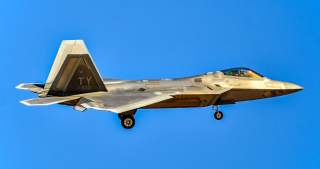I Can Tell You All of the Reasons Russia Hates the F-22 Raptor
It's everywhere.
The Raptors in question were part of the 95th’s four-plane deployment to the United Kingdom starting on April 11. Shortly after arriving at the Royal Air Force’s Lakenheath base, two of the F-22s joined up with a U.S. Air Force KC-135 tanker and, on April 25, hopped over to Mihail Kogalniceanu Air Base in Romania.
In 2013, the U.S. Air Force’s Alaska-based 3rd Wing devised a new way to deploy its F-22 Raptor stealth fighters in order to make them more survivable in a war with China.
Now the “Rapid Raptor” concept has a new goal—to deter Russian aggression.
(This article by David Axe originally appeared in War is Boring in 2016 and is being republished due to reader interest.)
The 3rd Wing’s scheme is simple. Instead of always painstakingly deploying entire 20-plane squadrons or even the whole 40-jet wing — as custom dictated — wing officers wrote new procedures for sending a quartet of F-22s plus a single supporting C-17 cargo plane practically anywhere in the Pacific region possessing a suitable airfield, all within 24 hours of the word “go.”
The 3rd Wing gave the idea its “Rapid Raptor” name and proudly briefed the concept to the Air Force’s chief of staff Gen. Mark Welsh. The aim was for the 3rd Wing, during wartime, to quickly disperse its F-22s across many bases instead of concentrating them at just one facility where they might be vulnerable to, say, a Chinese ballistic-missile barrage.
Rapid Raptor also helps the Air Force to make more efficient uses of its comparatively small fleet of 180 or so F-22s, just two-thirds of which actually have a combat role. The balance are training jets.
While it was the Chinese threat that drove Rapid Raptor’s development, today Russia — that is to say, the danger Russia poses to America’s European allies — sustains the concept. The Florida-based 95th Fighter Squadron adopted the 3rd Wing’s deployment procedures and, in April 2016, sent a pair of F-22s on a quick-fire tour of Eastern Europe.
“These aircraft have the ability to project air dominance quickly, at great distances, to defeat any possible threat,” said Lt. Gen. Timothy Ray, commander of the Third Air Force, which overseas U.S. air power in Europe and Africa.
The Raptors in question were part of the 95th’s four-plane deployment to the United Kingdom starting on April 11. Shortly after arriving at the Royal Air Force’s Lakenheath base, two of the F-22s joined up with a U.S. Air Force KC-135 tanker and, on April 25, hopped over to Mihail Kogalniceanu Air Base in Romania.
Two days later, the Raptors popped into Lithuania’s Šiauliai Air Base, where they regaled local officials with a speedy fly-by, depicted above.
Lithuanian president Dalia Grybauskaitė was impressed. “This is a demonstration that the United States is honoring its commitments,” she said, “and is ready to protect our region with all the most modern measures.”
For sure, Lithuania, in particular, is badly in need of some aerial protection. The country’s tiny air force boasts just a single subsonic L-39 light attack jet — and possesses no supersonic capability, at all. For air defense, Lithuania and NATO’s other Baltic members rely on a rotating contingent of jet fighters from larger alliance members.
Russian fighters, bombers and spy planes routinely probe the air space of Lithuania and neighboring countries. In 2015, NATO fighters scrambled 160 times to intercept Russian aircraft violating the air space of the alliance’s Baltic members, a 14-percent increase over 2014.
Image: Wikimedia Commons.

